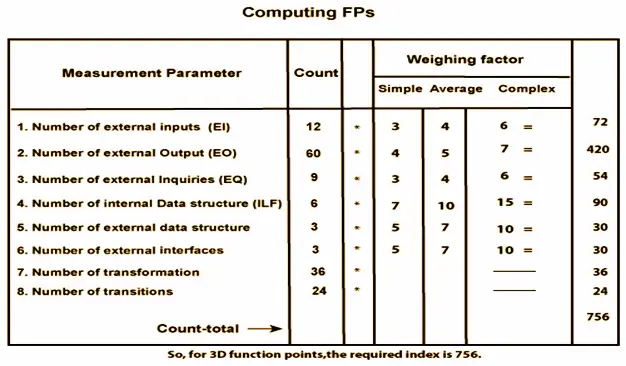Extended Function Point (EFP) Metrics is a software development metric that is based on the widely-used Function Point Analysis (FPA) method. While FPA is primarily used to measure the size and complexity of a software system, EFP takes it a step further by incorporating additional factors that impact the software development process. EFP enables software development teams to gain deeper insights into the effort and resources required for a project, and can be used to optimize the software development process. In this way, EFP provides a more comprehensive and detailed approach to measuring software development projects, enabling teams to make better decisions and improve overall productivity.
The Function Point Analysis (FPA) metric has been expanded to include the calculation of other metrics such as
- Feature Points
- 3D Function Points
These extensions allow for a more comprehensive analysis of software systems and applications, taking into account additional features and characteristics beyond the traditional FPA components.
Feature Points
- Feature point is a comprehensive measure that encompasses the function point measure and can be applied to systems and engineering software applications.
- Feature points are specifically useful in applications that have a high algorithmic complexity such as real-time systems with time constraints, embedded systems, etc.
- Feature points are calculated by counting the information domain values and are weighed by a single weight only.
- Feature point measurement includes an additional parameter, ALGORITHM, to consider the complexity of the algorithms used in the application.
- A table is used to compute the feature point, which consists of different weight values for information domain values and ALGORITHM parameters.
Feature Point Calculations
| Measurement Parameter | Count | Weighing factor | ||
|---|---|---|---|---|
| Number of external inputs (EI) | – | * | 4 | – |
| Number of external outputs (EO) | – | * | 5 | – |
| Number of external inquiries (EQ) | – | * | 4 | – |
| Number of internal files (ILF) | – | * | 7 | – |
| Number of external interfaces (EIF) | – | * | 7 | – |
| Algorithms used Count total | – | * | 3 | – |
3D Function Points
The 3D function point metric uses three dimensions – data, functional, and control – to represent software complexity.
- The data dimension is evaluated similarly to the traditional FPs calculation, where inputs, outputs, inquiries, external interfaces, and files are counted.
- The functional dimension includes a feature transformation, which captures the sequence of steps that transform input into output.
- The control dimension includes a feature transition, which is defined as the total number of transitions between states. Each state represents an externally observable mode.
- The 3D function point method was introduced by Boeing to address two limitations of the Albrecht approach.
Example:
Compute the 3D-function point value for an embedded system with the following characteristics
- Internal data structures: 6
- External data structures: 3
- Number of user inputs: 12
- Number of user outputs: 60
- Number of user inquiries: 9
- Number of external interfaces: 3
- Transformations: 36
- Transitions: 24
Using the 3D function point method, the values for the data dimension, functional dimension, and control dimension can be calculated based on these inputs.
- The data dimension value is obtained by counting inputs, outputs, inquiries, external interfaces, and files, as in the original function point method.
- For the functional dimension, the feature-Transformation value is added.
- For the control dimension, the feature-Transition value is added.
- Once the values for each dimension have been obtained, they are combined to give the 3D-function point value for the system.

Do collect complete information about the Functional Point (FP) Analysis in Software Engineering from this article if you want to brush up on your knowledge. For more updates in Software Engineering concepts bookmark our tutorials.freshersnow.com portal.
